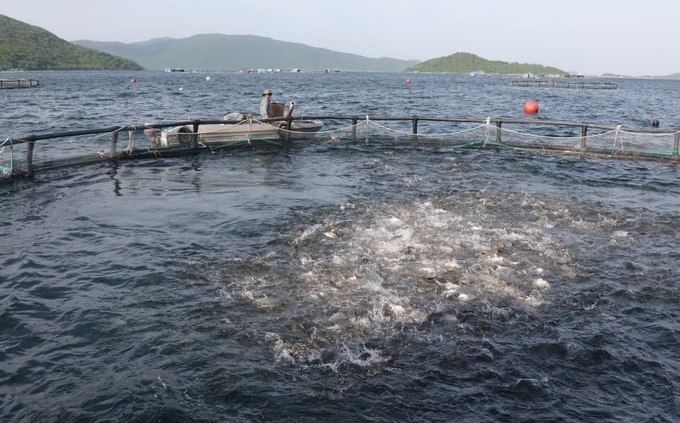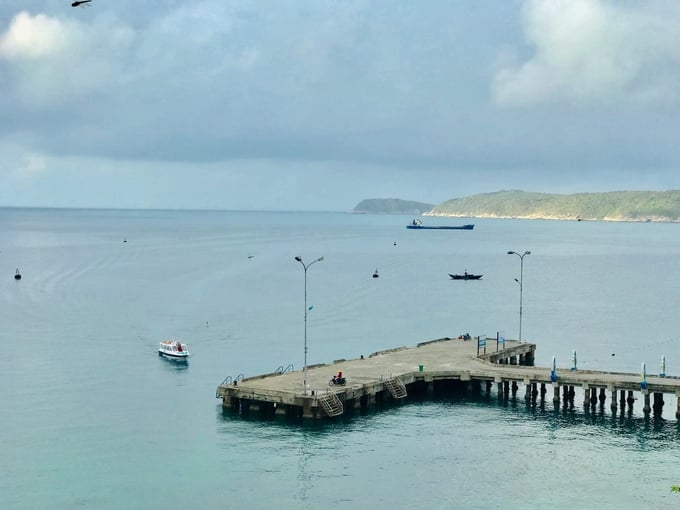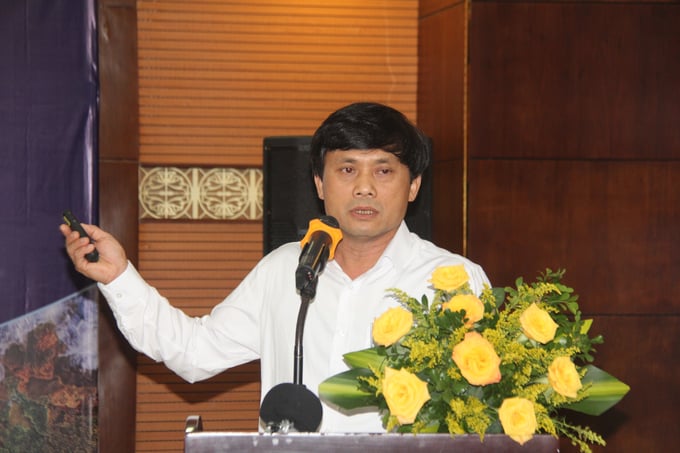November 27, 2025 | 10:59 GMT +7
November 27, 2025 | 10:59 GMT +7
Hotline: 0913.378.918
November 27, 2025 | 10:59 GMT +7
Hotline: 0913.378.918
The decline in seafood reserves and degradation of marine resources and biodiversity have been ringing alarm bells for many years. Since the 1970s, countries worldwide, such as the US, Japan, and Norway, have "fostered" marine life through natural marine farming to restore and regenerate aquatic resources.

Vietnam's strategy in the coming time to develop a sustainable fisheries industry is to increase marine farming and reduce exploitation. Photo: K.S.
Natural marine farming is understood as releasing the seed into the sea to reach commercial size and then exploiting it. This has two meanings. The first is to regenerate natural resources that are currently overexploited. Second, when seafood species have reached commercial size, exploitation will combine nature conservation, solving livelihood problems, and increasing income for people and businesses.
Mr. Le Tran Nguyen Hung, Head of the Department of Aquatic Resources Protection and Development (Department of Fisheries Surveillance, Ministry of Agriculture and Rural Development), affirmed that to realize Resolution 36-NQ/TW, dated October 22, 2018, of the Committee, Executive Committee of the 12th Party Central Committee on the Strategy for sustainable development of Vietnam's marine economy until 2030, with a vision to 2045, making Vietnam a robust maritime country, one of Vietnam's strategies is Reduce exploitation and increase marine aquaculture, including natural marine aquaculture.
There is no better area for natural marine farming than marine protected areas. The 27 marine protected areas to be formed shortly are divided into different areas: Strict protection area, Ecological restoration subdivision, service-administrative subdivision, and buffer zone. Marine protected areas are currently planned, which areas can be farmed and which species will be raised.

Marine protected areas are places where natural marine farming can be conducted in permitted subdivisions. Photo: L.K.
"In addition, 27 artificial habitats in 149 marine areas zoned to protect aquatic resources are also places for natural marine farming. We have investigated, evaluated, and determined the coordinate boundaries, scope, and environment well. Of course, it depends on the situation of each locality to have suitable areas.
Along with identifying natural marine farming areas, it is necessary to perfect artificial reproduction technology to restore endangered and rare species. From now to 2050, we are expected to complete artificial reproduction technology for about 18 species. After completion, it will be released for commercial farming, regenerative farming, and in natural waters," Mr. Hung informed.
Thus, it can be seen that natural marine farming is a solution that both regenerates high-value creatures and simultaneously brings economic value to individuals and businesses investing in this field. According to the Vietnam Seaculture Association, in addition to natural farming in marine protected areas, it can also be implemented in marine areas that businesses are assigned to manage.
However, to naturally farm the sea, it is necessary to pay attention to the ecological issues of the farmed species. Requires understanding, especially with new subjects. Only then can we come up with solutions suitable to the environmental characteristics of the species as well as the habitat and living characteristics for the most effective management and exploitation.
In reality, today, natural marine farming in our country was initially formed through the stocking of seafood in aquatic or environmental events with ornamental fish, tiger shrimp, and food fish; Or relocating and managing breeding colonies combined with coral reef restoration activities; Or raise green mussels, clams, clams, blood cockles... on tidal flats and shallow coastal waters.

Mr. Le Tran Nguyen Hung, Head of the Department of Aquatic Resources Protection and Development (Department of Fisheries Inspection, Ministry of Agriculture and Rural Development), said that in the coming time, it is necessary to perfect artificial reproduction technology to recover endangered and rare species. Photo: L.K.
Most marine farming activities are on a family scale, fragmented, small, spontaneous, with outdated technology, and unsustainable because of adverse environmental impacts. There are also many difficulties and obstacles due to the lack of planning and procedures for assigning marine areas to organizations and individuals. The state has not issued standards and regulations and lacks policies to support the development of natural marine farming.
According to Mr. Nguyen Huu Dung, Chairman of the Vietnam Seaculture Association, the development of seafaring not only protects and develops aquatic resources but is also a salvation, a fundamental and long-term solution to the IUU "yellow card" problem.
Mrs. Bui Thi Thu Hien, Manager of the Marine and Coastal Program International Union for Conservation of Nature IUCN Vietnam said: "The trend of natural marine farming combined with protecting and developing aquatic resources can be implemented in the ecosystem restoration area, administrative service area and buffer zone of the marine protected area with the participation of businesses. In these areas, businesses will act as an extended arm to support and protect areas that must be protected, avoiding illegal fishing activities. Of course, when participating in marine conservation areas, businesses must comply with some environmental regulations; not all fisheries activities can be carried out."
Translated by Tuan Huy
/2025/11/26/4909-2-154329_878.jpg)
(VAN) Pearl grouper farming in HDPE cages not only delivers economic efficiency but also contributes to protecting the environment, creating jobs, and promoting marine-based experiential tourism.

(VAN) The model of making a living under the forest canopy through the agroforestry system in Van Son commune, Bac Ninh province, is expected to generate an annual income of approximately VND 30 million/ha.

(VAN) Many enterprises in Can Tho are harnessing natural energy and reducing greenhouse gas emissions in their production processes, thereby contributing to the promotion of a sustainable green transition.
/2025/11/24/3536-2-112800_176.jpg)
(VAN) Dong Nai now has tens of thousands of hectares of forests certified for sustainable management, and this area will continue to be expanded in the coming period.

(VAN) Vinh Ha hamlet (Dai Xuyen commune, Hanoi) is shifting away from small-scale farming as households adopt bioscurity into their breeder chicken models.

(VAN) Heavy rains make aquatic species more vulnerable to disease. Proactive water management and high-tech systems help farmers prevent outbreaks and protect yields.

(VAN) Greenhouses are shifting production mindsets in Binh Lu commune, enabling farmers to ‘weather the sun and rain’ and secure stable vegetable harvests throughout the year.